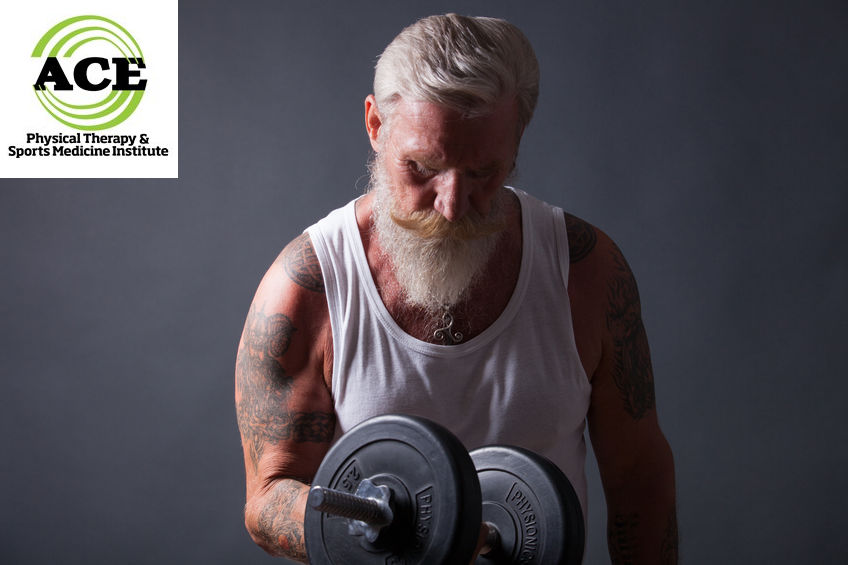TREATING OSTEOPOROSIS IN MEN WITH EXERCISE

Tid Bits of Info
- Over 200 million people worldwide have suffered from osteoporosis.
- Bone mineral density (BMD) is used to determine if one has osteoporosis.
- 2 million men have been diagnosed with osteoporosis in the U.S. and > 16 million have a low BMD.
- 40% of all osteoporotic fractures occur in men in the US.
- Seek the advice and treatment of a Physical Therapist to help with a sound resistance / jumping routine.
Osteoporosis causes bones to weaken and sometimes break. This common health condition is usually associated with aging and with women. Recent research suggests 40% of broken bones resulting from osteoporosis occur in men. Unfortunately, most men don’t seek treatment for the condition or when they do get diagnosed with the osteoporosis their compliance with the medical treatment is poor.
Osteoporosis is defined as “low bone mass with architectural deterioration of bone tissue”. This loss of bone mass leads to weakened, fragile bones susceptible to injury. To understand this condition, consider that healthy bones are constantly replenishing tissue (because bones are a form of tissue). New bone cells replace cells that have died or are non-functional and the “old” ones are reabsorbed. This is a naturally occurring process that helps to maintain the density and strength of a bone.
If the body does not manufacture “new” bone cells or the re-absorption process exceeds the production of new cells or both occur at the same time, the bone weakens as it becomes less dense, more porous and brittle. The key element in bone health is calcium levels. In the osteoporosis condition, too much calcium “leaves” the bone. Bones of the skeleton must be able to withstand the sheer and compressive forces of “life”. When these forces are too great the bone will break and lead to pain and loss of function. Osteoporosis is diagnosed through a bone density study. Unfortunately, osteoporosis does not have any significant “signs” in the early stages of its onset.
Traditionally osteoporosis with treated medicines designed to help eliminate the loss of calcium from the bone. New studies are examining the effects of resistance training exercises as a way of preserving the health of the bones. Bones will adapt to the forces that are applied to them. If someone is extremely sedentary and inactive the bone mass and density will be reduced. The forces on the bones that occur when the muscles contract and “pull” on the bone along with gravitational force help to stimulate the bone to produce new bone cells.
The use of resistance training and mild plyometric training has been studied and deemed useful as part of the treatment for prevention of osteoporosis. The use of weight training along with weight bearing plyometric exercises (jumping) that is performed a minimum of 3 times per week has been shown to increase the bone mass of several highly susceptible areas for osteoporosis fractures. The vertebra throughout the spine and Femoral neck all increased significantly. The bone mass throughout the entire skeleton increased in bone mass after 3 months of aggressive resistance training. The American College of Sports Medicine and the National Strength and Conditioning Association are strong proponents of resistive and jump training in the “senior” population. They promote using heavier weight and a low level “bounding” program to prevent the onset and progression of osteoporosis.
The use of resistive and jump training should be monitored by a trained healthcare professional when it is implemented. Like all exercises, the proper form will help to prevent injuries that can occur with poor form. Approximately 15-20 years ago the prescription for strength exercises for anyone over the age of 50 was to include very high repetitions with minimal resistance. That has changed in the past several years and it is recommended that anyone over the age of 50 strength train with heavier resistance and less repetitions. Any muscle contraction will aide in the prevention of the onset and progression of osteoporosis.
Physical Therapists are capable of designing an exercise routine for this patient population. They are licensed professionals that are well educated in the design and implementation of a sound resistance program. The program will be based on the availability of equipment and will include a low-level bounding/jumping program. The jumping will not involve jumping off or onto anything, but will have the patient do a routine that would mimic someone jumping rope. You do not need a prescription from your doctor to visit the Physical Therapist. You can be evaluated and treated by the Physical Therapist as a first line provider.
Osteoporosis is a condition that affects men and women. Healthcare professionals must pay more attention to their male patients as they age. Their need to use pharmacological treatment for osteoporosis can be reduced with a sound resistance-training program. In some instances, the use of these exercises, if implemented early in life, can eliminate the onset of the disease.

























